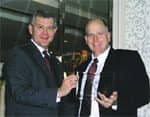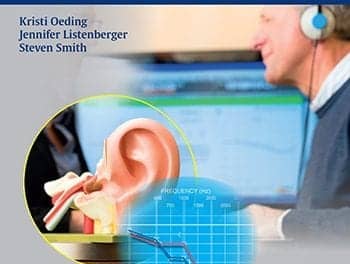SeboTek Hearing Systems’ Jim and Mike Feeley created the PAC to meet the needs of a diverse group of hearing instrument users.

Jim Feeley |

Mike Feeley |
It only took a moment of serendipity for the post-auricular canal (PAC) hearing instrument to be born, but since SeboTek Hearing Systems introduced it in April 2003, the device has met the needs of a diverse population of hearing aid users.
The idea for the PAC came about during a missionary trip that brothers Mike and Jim Feeley took to the southern jungles of Mexico. Traveling as missionaries for their church and as hearing instrument experts, the brothers outfitted those in need with hearing instruments, but were frustrated by the primitive conditions they encountered in the rural areas. Those conditions made fitting and maintenance difficult, especially for those with severe hearing loss.
Upon returning to the United States, the Feeleys began developing a new style of hearing aid that would meet the needs of all users. “The trip helped to define the product,” Jim says. “We realized that what was needed by everyone was the same product—no matter if they were in the developing or the developed world.”
The needs the brothers identified were anything but basic: a device that is cosmetically appealing and discreet; offers simple, same-day fitting; eliminates the feedback and occlusion-effect complaints typical with traditional hearing aids; delivers exceptional sound quality; can fit even severe hearing losses; and can be serviced on site.
The solution was the PAC system.

Sound PAC-ed system
Even though the idea for a comfortable, discreet, easy-to-service hearing instrument came to the Feeleys in a flash of insight, the development of the device took several years and combines the best of cutting-edge digital hearing aid technology into a simple, easy-to-fit design.
The PAC is a three-part modular system that is more discreet than a CIC and exceeds the sound quality of a digital BTE. The heart of the device is its patented design, which separates the sound processor from the speaker. The digital processor, which fits behind the ear, takes a size 13 battery and is available in several models with varying feature sets.
A thin-gauge external wire connects the sound processor with the hearing aid speaker, which is suspended in the ear canal. The wire or speaker link is available in three sizes: large, medium, and small. The speaker link enables the processor to rest comfortably behind the ear, while enabling the third element of the PAC—the ultra soft tip—to comfortably secure the speaker in the ear canal. The ultra soft tip comes in seven sizes.
The PAC design maximizes the use of the physics of sound while capitalizing on today’s digital technology, Mike says. “It allowed us to accomplish our goals,” he says. “It provides superior feedback management because it physically separates the microphone and the speaker farther apart than any ear level-worn hearing device in the world. And by taking all the components except the speaker out of the canal, it was a lot more comfortable and more discreet for the user.”
Because of the way the PAC is designed, the ultra soft tip provides a minimum contact seal, and it is that gentle seal that also eliminates the occlusion effect common with traditional products. Because it seals into place, the tip will not work its way out of position, even with excessive jaw movement.
The PAC offers more than comfort and aesthetics for the self-conscious hearing aid user; it offers performance as well.
The Perfect Fit
Jim says the PAC system offers the same sort of sea change for hearing aids that color offered for television viewing—hence the company’s slogan “Bringing Color to Sound.”
“When you look at the history of black-and-white television and its move to color television, it was a historic shift,” he says. “What we believe we’re doing is just as revolutionary. We’re breaking the mold.”
SeboTek’s PAC system is appropriate for those with mild, moderate, or severe hearing loss. It has an expanding frequency response to 14,000 Hz, giving the PAC a fuller, richer, and more three-dimensional sound. That expanded bandwidth enhances speech discrimination and improves sound quality.
Because of its simple design, it is easy to fit, taking just minutes since there is no impression to make, Jim says.
Fitting is a three-step process: selecting the appropriate speaker link, choosing the correct ultra soft tip size, and programming the sound processor. The processor is programmed using the SeboTek PRO-VES AutoFit system. Unlike a more traditional custom-made hearing instrument, PAC fittings are usually finished during the initial visit, with patients walking out of the office with the instrument in their ear. Though the fitting is simple, Mike emphasizes that the rest of the evaluation visit, which usually includes counseling the patient about their hearing loss, has not changed. The PAC just enables the evaluation and the fitting to be handled during a single visit, with the patient able to enjoy improved hearing immediately.
Prior to the sale, the device is also easy to demonstrate. The modular design means that the PAC is easy to service, with no downtime for the patient. Most service issues can be handled the same day.

Brotherly Love
While the PAC has found a worldwide following, SeboTek continues to do business from its headquarters in Tulsa, Okla.
The Feeleys brought more than 20 years of experience as dispensers and manufacturers to the table when they started SeboTek in 2001. Jim, who is president of the company, and Mike, who is vice president, have translated their close sibling dynamic into a successful working relationship. “We’ve always worked together,” Mike says. “We work well together, and share the same set of values.”
Jim sees the key to their success in that shared set of values. “I think the key is that we have a similar vision [for the company], with a level of trust,” he says.
The two men built their company with their religious beliefs in mind. Even the SeboTek name reflects that—sebo is a Greek word meaning “to worship the Lord.”
“Serving” is another word that comes up quite a bit in a discussion with the Feeleys. “In order to serve the industry, you have to listen to its needs,” Jim says.
Those needs are becoming ever clearer as Baby Boomers with decades’ worth of hearing damage come to need hearing instruments. As with most hearing instrument manufacturers, the Feeleys have recognized that “the color of sound” may be changing with the entrance of the Baby Boomer patients needing hearing instruments. “The Baby Boomers have changed every industry they have touched,” Mike says. “They demand same-day service, demand no feedback, and demand higher quality.” In short, they demand everything SeboTek offers.
But that does not mean that the Feeleys are resting on their laurels. They are busily working on products that will interface with cell phones, iPods, and the myriad of other instruments that are changing the way consumers live and listen.
The Feeleys are not only looking at a future of serving those who have hearing loss, but also helping to prevent it. This, again, reflects the demands of the market, which has seen various musicians spearhead highly publicized hearing loss prevention efforts and inspire interest in preventive measures.
Even though the hearing market continues to change, the Feeleys say that SeboTek’s mission will not. “Our purpose is to help people,” Mike says. “And we believe our products are helping people.”
C.A. Wolski is a contributing writer for Hearing Products Report.




